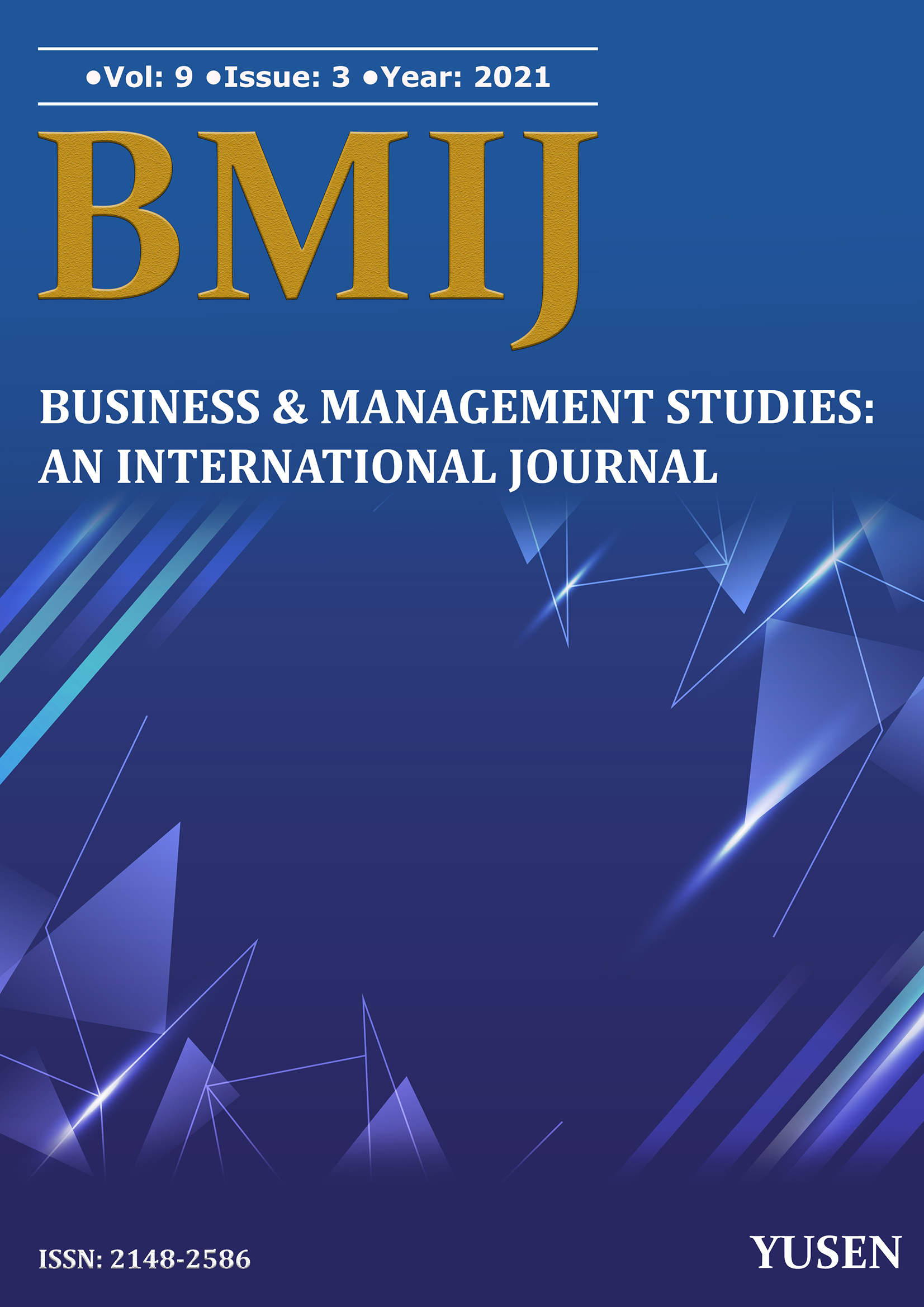Youth unemployment in the context of economic globalization and labour freedom: Dynamic panel data analysis

Published 2021-09-24
Keywords
- Genç İşsizliği, Ekonomik Büyüme, Ekonomik Küreselleşme, İşgücü Özgürlüğü, Dinamik Panel Veri Analizi
- Youth Unemployment, Economic Growth, Economic Globalization, Labor Freedom, Dynamic Panel Data Analysis
How to Cite
Copyright (c) 2021 Emrullah Mete

This work is licensed under a Creative Commons Attribution-NonCommercial-NoDerivatives 4.0 International License.
Abstract
The unemployment issue has been a significant problem that concerns all economies for many years. This issue mainly affected the young population because of social and psychological reasons. Youth unemployment is a problem in all developed and developing countries, not only in economic terms but also in the social dimension. Therefore, countries must constantly develop policies to solve the general unemployment and youth unemployment problem and increase society's welfare. This study investigated the effects of economic growth, economic globalization, labour freedom, wage level, and fixed capital formation on youth unemployment. In the analysis, data from 35 OECD member countries for the period 2005-2018 were used. As a method, a generalized method of moments (GMM) estimator was used within the scope of the dynamic panel data method. According to the analysis results, it has been determined that economic growth, economic globalization and fixed capital formation negatively affect youth unemployment.
Downloads
References
- Acedanski, J. (2016). Youth unemployment and welfare gains from eliminating business cycles — The case of Poland. Economic Modelling, 57, 248-262.
- Akbulut Yıldız, G. (2020). Gelişmekte Olan Ülkelerde işçi Dövizlerinin Finansal Gelişme Üzerindeki Etkisi: Dinamik Panel Veri Analizi. Maliye Dergisi, 178, 98-114.
- Arellano, M., ve Bond, S. (1991). Some Tests of Specification for Panel Data: Monte Carlo Evidence and an Application to Employment Equations. The Review of Economic Studies, 58(2), 277-297.
- Awad, A. (2019). Economic Globalisation and Youth Unemployment: Evidence from African Countries. International Economic Journal, 33(2), 252–269.
- Balcı-İzgi, B. ve Konu, A. (2019). Genç İşsizliğini Belirleyen Unsurlar: BRICS Ülkeleri ile Türkiye Panel ARDL Uygulaması. Dokuz Eylül Üniversitesi Sosyal Bilimler Enstitüsü Dergisi, 21(1), 95–112.
- Baltagi, B. (2005). Econometric Analysis of Panel Data. John Wiley & Sons.
- Caporale, G. M., & Gil-Alana, L. (2014). Youth unemployment in Europe: persistence and macroeconomic determinants. CESifo Working Paper, 4696(4), 1-19.
- Choudhry, M. T., Marelli, E. ve Signorelli, M. (2010). The Impact of Financial Crises on Youth Unemployment Rate. Quaderni del Dipartimentodi Economia, Finanza e Statistica, 79, 1-18.
- D’lppolito, N. (2011), Youth Unemployment the Cases of Denmark and Italy, Department of Economics Copenhagen Business School, Number of UBS: 180279.
- Güney, K. ve Cin, M.F. (2020). Avrupa Birliği ve Türkiye’de Genç İşsizliğinin Belirleyicileri: Panel Veri Analizi. ÇAKÜ Sosyal Bilimler Enstitüsü Dergisi, 11(1), 232-252.
- Güvenoğlu, H. ve Bayır, M. (2020). Genç İşsizliği Etkileyen Faktörlere İlişkin Ampirik Bir Analiz. Uluslararası iktisadi ve idari bilimler dergisi, 6(2), 19-36.
- Hallsten, M., Edling, C. ve Rydgren, J. (2017). Social capital, friendship networks, and youth unemployment. Social Science Research, 61, 234-250.
- Kanberoğlu, Z. ve Göçer, M. (2019). Türkiye’de inovasyonun Genç İşsizlik Üzerindeki Etkisi. International Journal of Economics and Politics Sciences Academic Researches, 3(9), 61-78.
- Kaslik, E., Neamtu, M. ve Vesa, L.F. (2021). Global stability analysis of an unemployment model with distributed delay. Mathematics and Computer in Simulation, 185, 535-546.
- Okun, A. (1962). Potential GNP: Its Measurement and Significance. Proceedings of the Business and Economic Statistics Section of the American Statistical Association, 7(1), 89-104.
- Polat, M. A. (2020). Ekonomik ve Politik Belirsizliklerin Yunanistan’daki Genç İşsizliğe Etkileri: Ampirik Bir Analiz. Yönetim ve Ekonomi Araştırmaları Dergisi, 18(2), 128-148.
- Sam, S. O. (2015). Modelling economic determinants of youth unemployment in Kenya. Unpublished Postgraduate Thesis. University of Nairobi, Kenya.
- Sertkaya, Y. ve Okur, A. (2016). Türkiye'de Genç İşsizliğinin Belirleyicilerine Yönelik Ekonometrik Bir Analiz. Ardahan Üniversitesi İktisadi ve İdari Bilimler Fakültesi Dergisi, 3, 155-168.
- Soylu, B. ve Aydın, B. N. (2020). Genç İşsizliğin Gelişimi, Belirleyicileri ve İktisadi Politikalar: Avrupa Birliği-Türkiye Karşılaştırması. EKEV Akademi Dergisi, 24(82), 339-360.
- Sönmez, F. D. ve Özerkek, Y. (2018). Türkiye'de Bölgesel Genç İşsizliğin Belirleyicileri. Marmara Üniversitesi İktisadi ve İdari Bilimler Dergisi, 40(2), 297-318.
- Tatoğlu, F.Y. (2013). İleri Panel Veri Analizi: Stata Uygulamalı (2.bs.). İstanbul: Beta.
- Üzar, U. ve Akyazı, H. (2018). Ekonomik Büyüme ve İşsizlik Arasındaki İlişkinin OECD Ülkeleri Düzeyinde Ekonometrik Bir Analizi. Cumhuriyet Üniversitesi İktisadi ve İdari Bilimler Dergisi, 19(2), 463-479.
- Yıldız, G. (2019). OECD Ülkeleri ve Türkiye’de Genç İşsizlik-Büyüme İlişkisi Üzerine Bir İnceleme. Yayınlanmamış Yüksek Lisans Tezi. Bilecik Şeyh Edebali Üniversitesi/Sosyal Bilimler Enstitüsü, Bilecik.


